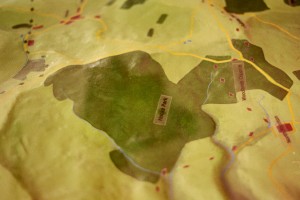Road for the Future
 December 2025
December 2025
Enter between two circular spiral timber sculptures, drive slowly along a drive curving through young trees, past temporary structures built as tests. Two halves of a platform or stage are folded up in a small clearing. An open workshop site with shipping containers full of tools, tarp covered timber and concrete structural joints. The indoor workshop is a double bubble of white plastic. Lo-fi futurist, sodium lit giving an orange glow from inside. Large scale machines and international students. A tent roof covers an angular structure adjacent. This is the communal kitchen dining room. The doors lean outwards, at an angle, and have to be pushed hard inwards to open them into a clean functional kitchen, and on to a dining room with raw timber structure ceiling.
Next to this building is a small garden, old kids climbing frames and toys now form homes for bantam hens. A green painted caravan with a balcony and chimes and glass beads in the window.
The squirrel trapper comes out of here in camoflage trousers a long sleeved t- shirt and heavy boots.
We walk and talk. The first trap is not far off the gravel track behind the caravan. A small wooden box about 60cm long and 20cm wide under a tree with a couple of logs either side of it, and two sticks across each open end.
He removes the sticks and uses one to pull out a metal trap. It’s empty but he demonstrates the mechanism, which springs with a loud snap. Pushes it back into the box and releases the safety catch. Replaces the sticks across the entrance. Squirrels are curious, so changes to this little environment will attract their attention.
It is the end of the season. In May there were around three a day from the twenty or so traps laid all around the site. Now it is rare to find one. The traps need checking every day and it takes about an hour by foot and mountain bike.
Squirrels are destructive to the trees. They ‘ring’ them by chewing a strip of bark around the base of the tree and it gradually dies. Some of the trees have evidence beneath them of pine-cones stripped back and bark curling off the trunk.
The land was purchased cheap in the late sixties by Makepeace, an architect from the Architectural Association. He was interested in finding a use for the saplings that needed thinning to manage the woodland. He set up the space for students to experiment with using the timber from the site to create buildings. The squirrel trapper is the son of the site workshop manager, and his mother runs the dining room. He does the job for three months of the year, a tenner a round, plus he cleans and helps on site.
The circuit leads up through long grass and older beech and oak trees. Each box is slightly different, same structure and principle, some numbered, some exposed on earthy ground, some almost hidden. The trapper dashes in and out of the woods, half running to check each one. One hand gets covered in ticks after disturbing some soil near one trap. He brushes them off before they get lodged. Further on thin pines up a steep bank covered with bracken and foxgloves. A high seat attached to a low pine overlooking the path we have taken. Deer run from a clearing of beech trees where the last trap is checked. Also empty.
